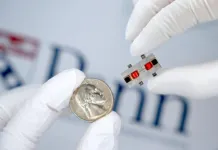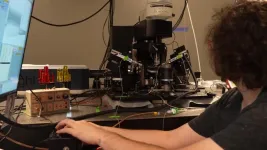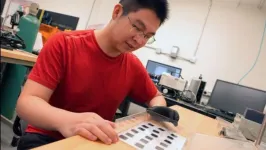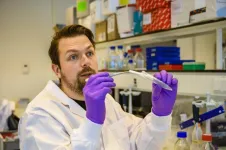(Press-News.org) In the early 2010s, LightSquared, a multibillion-dollar startup promising to revolutionize cellular communications, declared bankruptcy. The company couldn’t figure out how to prevent its signals from interfering with those of GPS systems.
Now, Penn Engineers have developed a new tool that could prevent such problems from ever happening again: an adjustable filter that can successfully prevent interference, even in higher-frequency bands of the electromagnetic spectrum.
“I hope it will enable the next generation of wireless communications,” says Troy Olsson, Associate Professor in Electrical and Systems Engineering (ESE) at Penn Engineering and the senior author of a new paper in Nature Communications that describes the filter.
The electromagnetic spectrum itself is one of the modern world’s most precious resources; only a tiny fraction of the spectrum, mostly radio waves, representing less than one billionth of one percent of the overall spectrum, is suitable for wireless communication.
The bands of that fraction of the spectrum are carefully controlled by the Federal Communications Commission (FCC), which only recently made available the Frequency Range 3 (FR3) band, including frequencies from about 7 GHz to 24 GHz, for commercial use. (One hertz is equivalent to a single oscillation in an electromagnetic wave passing a point each second; one gigahertz, or GHz, is a billion such oscillations per second.)
To date, wireless communications have mostly used lower-frequency bands. “Right now we work from 600 MHz to 6 GHz,” says Olsson. “That’s 5G, 4G, 3G.” Wireless devices use different filters for different frequencies, with the effect that covering all frequencies or bands requires large numbers of filters that take up substantial space. (The typical smartphone includes upwards of 100 filters, to ensure that signals from different bands don’t interfere with one another.)
“The FR3 band is most likely to roll out for 6G or Next G,” says Olsson, referring to the next generation of cellular networks, “and right now the performance of small-filter and low-loss switch technologies in those bands is highly limited. Having a filter that could be tunable across those bands means not having to put in another 100+ filters in your phone with many different switches. A filter like the one we created is the most viable path to using the FR3 band.”
One complication posed by using higher-frequency bands is that many frequencies have already been reserved for satellites. “Elon Musk’s Starlink works in those bands,” notes Olsson. “The military—they’ve already been crowded out of many lower bands. They’re not going to give up radar frequencies that sit right in those bands, or their satellite communications.”
As a result, Olsson’s lab—in collaboration with colleagues Mark Allen, Alfred Fitler Moore Professor in ESE, and Firooz Aflatouni, Associate Professor in ESE, and their respective groups—designed the filter to be adjustable, so that engineers can use it to selectively filter different frequencies, rather than have to employ separate filters. “Being tunable is going to be really important,” Olsson continues, “because at these higher frequencies you may not always have a dedicated block of spectrum just for commercial use.”
What makes the filter adjustable is a unique material, “yttrium iron garnet” (YIG), a blend of yttrium, a rare earth metal, along with iron and oxygen. “What’s special about YIG is that it propagates a magnetic spin wave,” says Olsson, referring to the type of wave created in magnetic materials when electrons spin in a synchronized fashion.
When exposed to a magnetic field, the magnetic spin wave generated by YIG changes frequency. “By adjusting the magnetic field,” says Xingyu Du, a doctoral student in Olsson’s lab and the first author of the paper, “the YIG filter achieves continuous frequency tuning across an extremely broad frequency band.”
As a result, the new filter can be tuned to any frequency between 3.4 GHz and 11.1 GHz, which covers much of the new territory the FCC has opened up in the FR3 band. “We hope to demonstrate that a single adaptable filter is sufficient for all the frequency bands,” says Du.
In addition to being tunable, the new filter is also tiny—about the same size as a quarter, in contrast to previous generations of YIG filters, which resembled large packs of index cards.
One reason the new filter is so small, and therefore could potentially be inserted into mobile phones in the future, is that it requires very little power. “We pioneered the design of a zero-static-power, magnetic-bias circuit,” says Du, referring to a type of circuit that creates a magnetic field without requiring any energy beyond the occasional pulse to readjust the field.
While YIG was discovered in the 1950s, and YIG filters have existed for decades, the combination of the novel circuit with extremely thin YIG films micromachined in the Singh Center for Nanotechnology dramatically reduced the new filter’s power consumption and size. “Our filter is 10 times smaller than current commercial YIG filters,” says Du.
In June, Olsson and Du will present the new filter at the 2024 Institute of Electrical and Electronics Engineers (IEEE) Microwave Theory and Techniques Society (MTT-S) International Microwave Symposium, in Washington, D.C.
This study was conducted at the University of Pennsylvania School of Engineering and Applied Science. It was supported by a grant from the Defense Advanced Research Projects Agency (FA8650-21-1-7010) and made use of resources sponsored by the National Science Foundation National Nanotechnology Coordinated Infrastructure Program (NNCI-1542153).
Additional co-authors include Mohamed Hossein Idjadi, Yixiao Ding, Tao Zhang, Alexander J. Geers, Shun Yao and Jun Beom Pyo at Penn Engineering.
END
To 6G and beyond: Penn engineers unlock the next generation of wireless communications
2024-05-24
ELSE PRESS RELEASES FROM THIS DATE:
USF researcher using VR to map the brain, understand and treat disorders such as autism
2024-05-24
TAMPA, Fla. (May 24, 2024) – Through high-tech imaging and virtual reality, a University of South Florida medical engineering professor is creating a detailed map of the brain that can be used to better understand developmental disorders, such as autism, and provide earlier, more effective treatments for brain injuries and diseases.
Funded by a $3.3 million grant from the National Institutes of Health, George Spirou is expanding on his four decades of brain research to focus on the part of the brain that ...
Semaglutide significantly reduces risk of major kidney disease events, cardiovascular outcomes and mortality in patients with type 2 diabetes and chronic kidney disease, groundbreaking study reveals
2024-05-24
Semaglutide significantly reduces risk of major kidney disease events, cardiovascular outcomes and mortality in patients with type 2 diabetes and chronic kidney disease, groundbreaking study reveals
A pioneering study has demonstrated that semaglutide significantly reduces the risk of major kidney disease events, cardiovascular outcomes, and all-cause mortality in patients with type 2 diabetes and chronic kidney disease.1 The landmark trial, presented today at the 61st ERA Congress, will pave the way for new treatment strategies and ...
Unveiling a novel AAK1 inhibitor: How chemical proteomics unlocked therapeutic potential
2024-05-24
Enhancing drug development for life-threatening diseases like cancer hinges on a deep understanding of protein kinases, making it a focal point for researchers. These enzymes, encoded by more than 500 human genes, serve as critical players in cellular signaling pathways. However, if these signals are dysregulated, they can disrupt the normal cellular mechanisms, leading to diseases such as cancer. Protein kinase inhibitors have therefore provided a promising avenue in therapeutic intervention to disrupt the aberrant signaling ...
Novel organic photoredox catalysts with enhanced stability and recyclability
2024-05-24
In recent years, global environmental concerns have prompted a shift toward eco-friendly manufacturing in the field of organic synthetic chemistry. In this regard, research into photoredox catalytic reactions, which use light to initiate redox or reduction-oxidation reactions via a photoredox catalyst, has gained significant attention. This approach reduces the reliance on harsh and toxic reagents and uses visible light, a clean energy source.
A key research area has been the development of recycling methods for photocatalysts, which offer both economic and environmental benefits. Photocatalysts use light to accelerate a chemical reaction without getting consumed in the process, and photoredox ...
Imperceptible sensors made from ‘electronic spider silk’ can be printed directly on human skin
2024-05-24
Researchers have developed a method to make adaptive and eco-friendly sensors that can be directly and imperceptibly printed onto a wide range of biological surfaces, whether that’s a finger or a flower petal.
The method, developed by researchers from the University of Cambridge, takes its inspiration from spider silk, which can conform and stick to a range of surfaces. These ‘spider silks’ also incorporate bioelectronics, so that different sensing capabilities can be added to the ‘web’.
The fibres, at least 50 times smaller than a ...
Virginia Tech researcher’s breakthrough discovery uses engineered surfaces to shed heat
2024-05-24
Splash a few drops of water on a hot pan and if the pan is hot enough, the water will sizzle and the droplets of water seem to roll and float, hovering above the surface.
The temperature at which this phenomenon, called the Leidenfrost effect, occurs is predictable, usually happening above 230 degrees Celsius. The team of Jiangtao Cheng, associate professor in the Virginia Tech Department of Mechanical Engineering, has discovered a method to create the aquatic levitation at a much lower temperature, and the results have been published in Nature ...
How a tiny device could lead to big physics discoveries and better lasers
2024-05-24
Researchers at Rensselaer Polytechnic Institute have fabricated a device no wider than a human hair that will help physicists investigate the fundamental nature of matter and light. Their findings, published in the journal Nature Nanotechnology, could also support the development of more efficient lasers, which are used in fields ranging from medicine to manufacturing.
The device is made of a special kind of material called a photonic topological insulator. A photonic topological insulator can guide photons, the wave-like particles that make up light, ...
Ambitious targets are needed to end ocean plastic pollution by 2100
2024-05-24
The study, a collaboration between researchers at Imperial College London and GNS Science, suggests that reducing plastic pollution by 5% per year would stabilize the level of microplastics – plastics less than 5 mm in length – in the surface oceans.
However, the modelling shows that even reducing pollution by 20% per year would not significantly reduce existing microplastics levels, meaning they will persist in our oceans beyond 2100.
Microplastics have been found to be circulating in all of the Earth’s oceans and some of the greatest concentrations of them are thousands of miles from land. These tiny particles ...
Boost for research aiming to cure chronic diseases in an aging population
2024-05-24
The DRIVE-RM consortium, led by Professor of Experimental Nephrology Marianne Verhaar from UMC Utrecht, has been awarded €37.5 million under the prestigious NWO SUMMIT program. The SUMMIT grant recognizes world-class collaborations, while further strengthening these partnerships. The DRIVE-RM collaboration involves UMC Utrecht, Utrecht University, Eindhoven University of Technology, Maastricht University, and the Hubrecht Institute, focusing on smart materials that assist the body in healing.
Regenerative medicine involves repairing or replacing damaged tissues and organs by leveraging the body's own healing processes. DRIVE-RM ...
Quadruple therapies and the future of multiple myeloma treatment
2024-05-24
MIAMI, FLORIDA (MAY 23, 2024) – The treatment landscape for multiple myeloma, the second most common blood cancer, is shifting rapidly, with newly diagnosed patients increasingly being treated with a four-part drug combination that includes a new immunotherapy agent.
Over the last decade, options have evolved from double, to triple to quadruple combination therapies. What do these new options mean for patients, and how will treatment change in the future?
C. Ola Landgren, M.D., Ph.D., will ...










